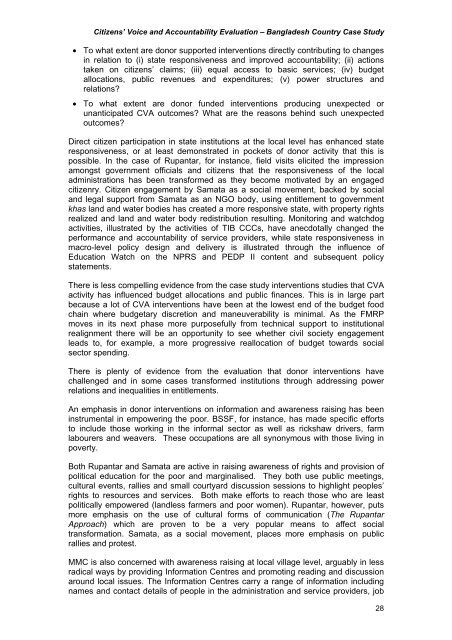Bangladesh - Belgium
Bangladesh - Belgium
Bangladesh - Belgium
Create successful ePaper yourself
Turn your PDF publications into a flip-book with our unique Google optimized e-Paper software.
Citizens’ Voice and Accountability Evaluation – <strong>Bangladesh</strong> Country Case Study<br />
• To what extent are donor supported interventions directly contributing to changes<br />
in relation to (i) state responsiveness and improved accountability; (ii) actions<br />
taken on citizens’ claims; (iii) equal access to basic services; (iv) budget<br />
allocations, public revenues and expenditures; (v) power structures and<br />
relations?<br />
• To what extent are donor funded interventions producing unexpected or<br />
unanticipated CVA outcomes? What are the reasons behind such unexpected<br />
outcomes?<br />
Direct citizen participation in state institutions at the local level has enhanced state<br />
responsiveness, or at least demonstrated in pockets of donor activity that this is<br />
possible. In the case of Rupantar, for instance, field visits elicited the impression<br />
amongst government officials and citizens that the responsiveness of the local<br />
administrations has been transformed as they become motivated by an engaged<br />
citizenry. Citizen engagement by Samata as a social movement, backed by social<br />
and legal support from Samata as an NGO body, using entitlement to government<br />
khas land and water bodies has created a more responsive state, with property rights<br />
realized and land and water body redistribution resulting. Monitoring and watchdog<br />
activities, illustrated by the activities of TIB CCCs, have anecdotally changed the<br />
performance and accountability of service providers, while state responsiveness in<br />
macro-level policy design and delivery is illustrated through the influence of<br />
Education Watch on the NPRS and PEDP II content and subsequent policy<br />
statements.<br />
There is less compelling evidence from the case study interventions studies that CVA<br />
activity has influenced budget allocations and public finances. This is in large part<br />
because a lot of CVA interventions have been at the lowest end of the budget food<br />
chain where budgetary discretion and maneuverability is minimal. As the FMRP<br />
moves in its next phase more purposefully from technical support to institutional<br />
realignment there will be an opportunity to see whether civil society engagement<br />
leads to, for example, a more progressive reallocation of budget towards social<br />
sector spending.<br />
There is plenty of evidence from the evaluation that donor interventions have<br />
challenged and in some cases transformed institutions through addressing power<br />
relations and inequalities in entitlements.<br />
An emphasis in donor interventions on information and awareness raising has been<br />
instrumental in empowering the poor. BSSF, for instance, has made specific efforts<br />
to include those working in the informal sector as well as rickshaw drivers, farm<br />
labourers and weavers. These occupations are all synonymous with those living in<br />
poverty.<br />
Both Rupantar and Samata are active in raising awareness of rights and provision of<br />
political education for the poor and marginalised. They both use public meetings,<br />
cultural events, rallies and small courtyard discussion sessions to highlight peoples’<br />
rights to resources and services. Both make efforts to reach those who are least<br />
politically empowered (landless farmers and poor women). Rupantar, however, puts<br />
more emphasis on the use of cultural forms of communication (The Rupantar<br />
Approach) which are proven to be a very popular means to affect social<br />
transformation. Samata, as a social movement, places more emphasis on public<br />
rallies and protest.<br />
MMC is also concerned with awareness raising at local village level, arguably in less<br />
radical ways by providing Information Centres and promoting reading and discussion<br />
around local issues. The Information Centres carry a range of information including<br />
names and contact details of people in the administration and service providers, job<br />
28

















